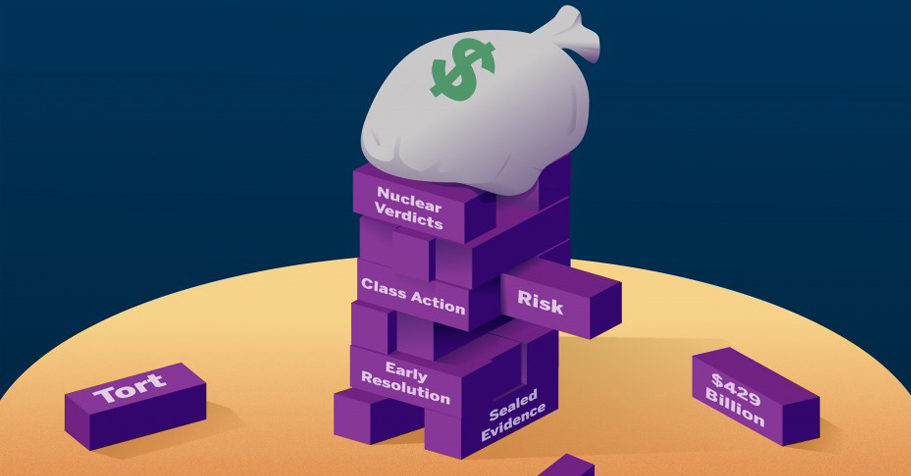- Home
- / Insights
- / FTI Journal
Staying Out of the Monetary Minefield of Today’s Litigation Landscape

-
August 31, 2020
-
Massive jury awards have elevated litigation to the level of strategic risk for insurance carriers. What’s behind this trend?
Last year, the outcome of 10 high-profile U.S. tort cases resulted in payouts to defendants of more than $815 million. Amazingly, more than half of that total came from a single trial.
For almost two decades now, multimillion-dollar jury awards have turned the litigation landscape into a monetary minefield for insurance carriers. Known as “nuclear verdicts,” the outsized compensation has raised litigation to the level of strategic risk for carriers.
A number of factors both within the litigation landscape itself and outside are driving this trend.
Perhaps the most familiar factor is the allure of “easy money” for prosecuting firms and other behind-the-scenes parties. According to a 2018 report by the U.S. Chamber Institute for Legal Reform (a separately incorporated affiliate of the U.S. Chamber of Commerce), only 57 cents of every dollar in tort case outcomes is paid to the plaintiff. The remainder goes toward attorneys’ fees, insurance and administrative costs.
Another major factor involves prosecuting attorneys’ attempting to persuade juries to side with injured parties by appealing to an anti-corporate sentiment that stretches back at least to the 2008 financial crisis. Stoked by distrust — if not disdain — for the motives of large corporations pitted against the “little guy,” some juries have gone so far as to double the compensation paid to plaintiffs in a trend that has become known as “social inflation.”
It all adds up. The Institute for Legal Reform report stated that cost and compensation paid by the U.S. tort system in 2016 totaled $429 billion. That’s 2.3% of the U.S. gross domestic product for that year.
Under these circumstances, it’s not surprising that insurance carriers might be hesitant to underwrite policies. A nuclear verdict can influence the outcomes of subsequent cases; it can affect the pricing of an institution’s risk portfolio and alter its reserve requirement.
But by understanding the factors and their impact on an institution’s particular ecosystem, it’s possible to build resolution strategies that allow carriers to take on the risk of litigation.
Other External Factors
Litigation Funding
Like many industries with potential for future large returns, mass tort lawsuits have attracted hedge funds and private equity into the marketplace. In 2018, The New York Times estimated that hedge fund financing of such cases can carry interest rates as high as 18 percent.
Institutional investors see this as a new asset class for their portfolios. But given the great effort it takes to perform due diligence on individual cases, as well as the goals and other legal restrictions that may impact performance, some funds are choosing to invest in a law firm’s full caseload.
Tortreform.com reported that London-based Burford Capital estimated it earned a 37 percent return on its lawsuit investments in 2017 alone.
Climate Change
Spurred on by a growing impatience with both corporations’ and governments’ responses to the climate change crisis, disgruntled parties around the world have created a surge in climate-related lawsuits. To date, 1,600 suits have been filed, with 1,200 in the U.S. alone, according to the London School of Economics.
In June, the District of Columbia filed legal action against four oil majors for “systematically and intentionally misleading” consumers about their roles in causing climate change.
Still, climate-change cases can be complex and difficult to resolve. In January, a three-judge panel dismissed Juliana v. United States, a lawsuit filed by 21 young people against the federal government for violating the youngest generation’s “constitutional rights to life, liberty, and property, as well as [failing] to protect essential public trust resources.”
Judge Andrew Hurwitz of the 9th Circuit Court of Appeals in San Francisco concluded that this was an issue for the executive and legislative branches.
Sealing of Verdicts
In 2004, Purdue Pharma, manufacturer of OxyContin, filed a motion to dismiss the State of West Virginia’s case accusing the pharma giant of minimizing the risks associated with the addictive painkiller. Judge Booker T. Stephens of the West Virginia Circuit Court rejected Purdue’s motion and in the process sealed thousands of pages of evidence he used as the basis for his ruling; Purdue had submitted the material in the pretrial discovery phase of the case.
That evidence would remain sealed for more than a decade.
According to a recent special report by Reuters, in the past 20 years, “judges sealed evidence relevant to public health and safety in about half of the 115 biggest defective-product cases consolidated before federal judges in so-called multidistrict litigation.” The cases, 250,000 in number, are all individual death and injury lawsuits against consumer products.
Key Takeaways
While the long-discussed tort reform continues to be debated and litigation cases become more complex, one key for carriers is to work within their own ecosystems to understand all factors and assess tolerance for risk. Like any underwriting process, collecting as much quality data as possible provides the insights to make a decision with confidence.
If litigation is at hand, having discussions as soon as possible with client and counsel to explore alternative resolutions is wise. Early intervention and assessment of the facts can improve your control over the dispute resolution process and even reduce the cost of settlement.
We live in an era of constant disruption. For insurance companies, bold action is the best course not only to managing, but to thriving.
© Copyright 2020. The views expressed herein are those of the author and do not necessarily represent the views of FTI Consulting, Inc. or its other professionals.
About The Journal
The FTI Journal publication offers deep and engaging insights to contextualize the issues that matter, and explores topics that will impact the risks your business faces and its reputation.
Related Insights
Related Information
Published
August 31, 2020
 Key Contacts
Key Contacts
Senior Managing Director, Co-Leader of Insurance Services